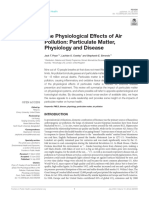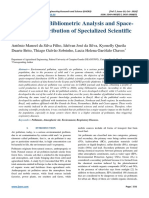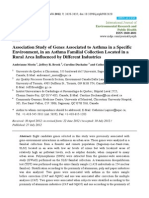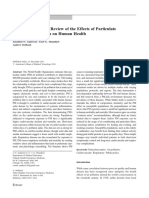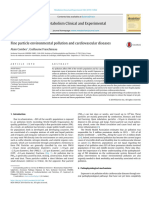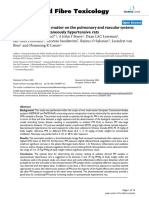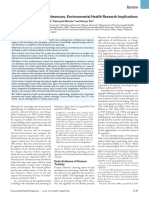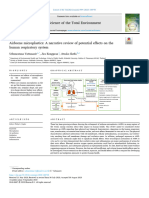The Neurological Effects of Air Pollution in Children: Editorial
The Neurological Effects of Air Pollution in Children: Editorial
Uploaded by
lukasCopyright:
Available Formats
The Neurological Effects of Air Pollution in Children: Editorial
The Neurological Effects of Air Pollution in Children: Editorial
Uploaded by
lukasOriginal Title
Copyright
Available Formats
Share this document
Did you find this document useful?
Is this content inappropriate?
Copyright:
Available Formats
The Neurological Effects of Air Pollution in Children: Editorial
The Neurological Effects of Air Pollution in Children: Editorial
Uploaded by
lukasCopyright:
Available Formats
Eur Respir J 2008; 32: 535–537
DOI: 10.1183/09031936.00073708
CopyrightßERS Journals Ltd 2008
EDITORIAL
The neurological effects of air pollution in children
J. Sunyer*,#,"
nvironmental exposures in utero and during early life consecutive days in 181 pregnant women from New York City
E may permanently change the body’s structure, physiol-
ogy and metabolism, and lead to diseases in adult life [1].
Infants are particularly vulnerable because of their rapid growth
(NY, USA), to mental health measured at age 3 yrs in their
offspring [11]. The short measurement of the exposure (only
2 days), their narrow variability (only low and high levels), and
and cell differentiation, immaturity of metabolic pathways and the poor specificity of PAH (the principal source is smoking)
development of vital organ systems. The central nervous system resulted in preliminary research that is not very conclusive. The
has unprotected barriers and a broad time window of conforma- second study related average air pollution exposure during
tion, leading to a long period of vulnerability in the developmental childhood (carbon particles at home address derived by spatial
process and to susceptibility to any environmental insult [2]. modelling) to intelligence at age 9 yrs in 202 children from
Research conducted among a limited series of pollutants (includ- Boston (MA, USA) [12]. The study, however, followed only 20%
ing lead, mercury and polycyclic aromatic hydrocarbons (PAH)) of those recruited and did not measure prospectively the
shows that early-life exposure to chemicals at current environ- variations in air pollution or the time-activity patterns of the
mental levels can be neurotoxic years or even decades after participants. The two studies adjusted for potential confoun-
exposure [3]. ders, such as socio-economic conditions or internal doses of
lead, but failed to adjust for other factors, such as noise. Overall,
Traffic-related air pollution, basically urban outdoor pollution, these two studies were the first to translate into humans the
is a global public health problem [4]. Cardiorespiratory effects evidence suggested in animal studies, but their deficiencies in
and mechanisms have been fully investigated [5]. In contrast, size and design call for larger and more detailed research.
little is known regarding neurological effects, with only some
preliminary evidence. In rats, ultrafine carbon particles have THE LUNG AND THE UNDERLYING MECHANISMS
been found in the olfactory bulb and the cerebrum and Oxidative stress, changes in autonomous function and progres-
cerebellum after inhalation exposure [6]; this finding has been sion of atherosclerosis have been hypothesised to be mechanisms
reproduced more recently with manganese particles directly of the neurological effect of urban air pollution in humans at any
translocated to the olfactory nerve from the nose to the brain [7]. age [13]. Among them, inflammation secondary to oxidative
In one study, dogs living in a highly polluted region in Mexico stress appears to be the major suspected culprit for delay in
City (Mexico) had an increase in brain inflammation compared conformation and maturation during developmental steps. Even
with animals living in a less polluted area [8]. The brain tissue of though most of the available research about the inflammatory
animals from Mexico City had higher levels of nuclear factor-kB effects of air pollution refers to the lungs, there is evidence that
activation and nitric oxide production, as well as the principal the oxidative stress and inflammation induced by particles
pro-inflammatory cytokines interleukin (IL)-1 and tumour translates systemically beyond the lungs [14]. For example, we
necrosis factor (TNF)-a, compared with the animals from the found in an international longitudinal study of 1,003 adult
nonpolluted area [9]. In a study on human autopsies in Mexico subjects that particle count increased markers of systemic
City, exposure to severe air pollution has been associated with inflammation (IL-6 and fibrinogen peripheral levels) [15].
increased levels of cyclooxygenase (COX)-2 and accumulation
of the 42-amino-acid form of b-amyloid, a cause of neuronal The major underlying hypothesis is that chronic respiratory
dysfunction [10]. tract inflammation may lead to brain inflammation by altering
levels of circulating cytokines, such as TNF-a and IL-1. These
There are two small studies in children from the general cytokines have the ability to upregulate COX-2, a potent active
population exposed to urban air. The first study related PAH in mediator of inflammation, in capillary brain endothelium [16].
particulate form, as collected with individual pumps during two Changes in brain cytokine and chemokine expression in mice
have been directly linked to intranasal exposure to ultrafine
carbon [17]. Carbon particles themselves generally adsorb
*Centre for Environmental Epidemiological Research (CREAL), #Municipal Institute of Medical transition metals (including antimony, barium, copper, iron
Research (IMIM), Universitat Pompeu Fabra, Barcelona, and "El Centro de Investigación Biomédica and zinc) emitted from traffic exhaust and also from tyres and
en Red de Epidemiologı́a y Salud Pública (CIBERESP), Spain. brake wear. These metals, which are mainly generated by
SUPPORT STATEMENT: J. Sunyer has received funds for research from the European Union, the traffic in the current urban atmospheres [18], have been shown
government of Spain and Catalonia, and La Caixa Fundation. to induce oxidative stress in the lung [16].
STATEMENT OF INTEREST: None declared. An alternative hypothetical mechanism of the neurological
CORRESPONDENCE: J. Sunyer, CREAL-IMIM, Dr Aiguader 88, 08003 Barcelona, Spain. Fax: 34
933160575. E-mail: jsunyer@imim.es
effect of air pollution is based on the observation that ultrafine
particles containing metals translocate directly to the brain, c
EUROPEAN RESPIRATORY JOURNAL VOLUME 32 NUMBER 3 535
NEUROLOGICAL AIR POLLUTION EFFECTS IN CHILDREN J. SUNYER
without entering the lung [7]. Changes in cognitive function in individual exposure to air pollutants and antioxidants, and of
children have been shown to be associated with relatively low the genetic contribution) to further investigate the suspicion that
internal doses of lead [19] and mercury [3]. In addition to being our urban air is neurotoxic for our children.
linked to cognitive deficits in children, lead has been related to
a diversity of behavioural problems (reading problems, school
failure and delinquent behaviour), with a high social impact REFERENCES
[20]. In experimental studies, some metals, such as mercury 1 Gluckman PD, Hanson MA. Living with the past: evolu-
and lead, inhibit neuronal differentiation, myelinisation and tion, development, and patterns of disease. Science 2004;
synaptogenesis [21], but the specific mechanisms for lead- 305: 1733–1736.
induced intellectual deficits have not been fully elucidated. 2 Landrigan PJ, Sonawane B, Butler RN, Trasande L, Callan R,
Droller D. Early environmental origins of neurodegenera-
THE CONSTELLATION OF FACTORS IN BRAIN tive disease in later life. Environ Health Perspect 2005; 113:
MATURATION 1230–1233.
A well-known constellation of factors related to neurodevelop- 3 Grandjean P, Landrigan PJ. Developmental neurotoxicity
ment could all play a confounding role or they could explain of industrial chemicals. Lancet 2006; 368: 2167–2178.
differences in vulnerability of the dose–response relationship 4 World Bank. World Development Indicators. Environment:
between air pollution and neurodevelopment [20]. These factors Air Pollution. Washington, World Bank Group, 2007. http://
must be considered and include, for example, the social siteresources.worldbank.org/datastatistics/resources/
environment (including parental psychological status), breast- table3_13.pdf
feeding, diet, maternal smoking, birthweight and noise [22]; 5 Kaiser J. Mounting evidence indicts fine-particle pollution.
along with other pollutants such as lead, mercury, DDT and Science 2005; 307: 1858–1861.
indoor air pollutants (those originating from indoor sources, 6 Donaldson K, Tran L, Jimenez LA, et al. Combustion-
such as heating and cooking, or from microbial contaminants, derived nanoparticles: a review of their toxicology follow-
such as endotoxins). Endotoxins are the common structural ing inhalation exposure. Part Fibre Toxicol 2005; 2: 10.
component of Gram-negative bacteria in indoor air that induced 7 Elder A, Gelein R, Silva V, et al. Translocation of inhaled
chronic inflammation in the rat brain [23]. ultrafine manganese oxide particles to the central nervous
system. Environ Health Perspect 2006; 114: 1172–1178.
Therefore, it is important to examine diet, since it is a major 8 Calderón-Garcidueñas L, Azzarelli B, Acuna H, et al. Air
source of antioxidants. Antioxidant defence mechanisms could pollution and brain damage. Toxicol Pathol 2002; 30: 373–389.
be increased by dietary means (vitamins, omega-3 (docosa- 9 Campbell A, Oldham M, Becaria A, et al. Particulate matter
hexaenoic acid) and omega-6 (arachidonic acid) fatty acids, and in polluted air may increase biomarkers of inflammation in
other micronutrients (zinc and folic acid)) to protect against air mouse brain. Neurotoxicology 2005; 26: 133–140.
pollutants [24]. Antioxidants in the lung are the first line of 10 Calderón-Garcidueñas L, Reed W, Maronpot RR, et al.
defence against oxygen free radicals. All of these antioxidants are Brain inflammation and Alzheimer’s-like pathology in
free radical scavengers and they react rapidly to limit interaction individuals exposed to severe air pollution. Toxicol Pathol
with lung fluid lipids and proteins [25]. The brain is particularly 2004; 32: 650–658.
susceptible to free radical-mediated insult, due to its inherent 11 Perera FP, Rauh V, Whyatt RM, et al. Effect of prenatal
biochemical and physiological characteristics, including high exposure to airborne polycyclic aromatic hydrocarbons on
lipid content and energy requirements [26]. Reactive oxygen neurodevelopment in the first 3 years of life among inner-
species are generated continuously in the nervous system during city children. Environ Health Perspect 2006; 114: 1287–1292.
normal metabolism and neuronal activity [27]. Similarly, genetic 12 Suglia SF, Gryparis A, Wright RO, Schwartz J, Wright RJ.
background may result in a differential susceptibility toward the Association of black carbon with cognition among children
oxidative stress pathway [28]. For example, antioxidant supple- in a prospective birth cohort study. Am J Epidemiol 2008;
mentation with vitamins C and E appears to modulate the effect 167: 280–286.
of ozone in asthmatic children homozygous for the GSTM1 null 13 Peters A, Veronesi B, Calderón-Garcidueñas L, et al.
allele [29]. Inflammatory cytokines released in the periphery (e.g. Translocation and potential neurological effects of fine
respiratory epithelia) upregulate the innate immune Toll-like and ultrafine particles: a critical update. Part Fibre Toxicol
receptor 2. Such activation and the subsequent events leading to 2006; 3: 13.
neurodegeneration have recently been observed in lung lavage in 14 Hirano S, Furuyama A, Koike E, Kobayashi T. Oxidative-
mice exposed to ambient Los Angeles (CA, USA) particulate stress potency of organic extracts of diesel exhaust and
matter [30]. urban fine particles in rat heart microvessel endothelial
cells. Toxicology 2003; 187: 161–170.
CONCLUSION 15 Rückerl R, Greven S, Ljungman P, et al. Air pollution and
The study of chronic effects of urban air pollution should inflammation (interleukin-6, C-reactive protein, fibrino-
incorporate subtle health effects, such as functional delays in gen) in myocardial infarction survivors. Environ Health
brain maturation and impairment of neurobehavioural compe- Perspect 2007; 115: 1072–1080.
tences, from early life exposures. The long-term consequences of 16 Campbell A. Inflammation, neurodegenerative diseases,
these effects in the co-causation of neurodegenerative diseases and environmental exposures. Ann NY Acad Sci 2004; 1035:
have so far only been speculated, but it is time for multi- 117–132.
disciplinary research in human populations (including neuro- 17 Tin-Tin-Win-Shwe, Yamamoto S, Ahmed S, Kakeyama M,
behavioural and lung examination, and assessments of Kobayashi T, Fujimaki H. Brain cytokine and chemokine
536 VOLUME 32 NUMBER 3 EUROPEAN RESPIRATORY JOURNAL
J. SUNYER NEUROLOGICAL AIR POLLUTION EFFECTS IN CHILDREN
mRNA expression in mice induced by intranasal instillation 24 Kelly FJ. Dietary antioxidants and environmental stress.
with ultrafine carbon black. Toxicol Lett 2006; 163: 153–160. Proc Nutr Soc 2004; 63: 579–585.
18 Steiner M, Boller M, Schulz T, Pronk W. Modelling heavy 25 Beck-Speier I, Dayal N, Karg E, et al. Oxidative stress
metal fluxes from traffic into the environment. J Environ and lipid mediators induced in alveolar macrophages
Monit 2007; 9: 847–854. by ultrafine particles. Free Radic Biol Med 2005; 38:
19 Lanphear BP, Hornung R, Khoury J, et al. Low-level 1080–1092.
environmental lead exposure and children’s intellectual 26 Pajović SB, Saicić ZS, Spasić MB, Petrović VM. The effect of
function: an international pooled analysis. Environ Health ovarian hormones on antioxidant enzyme activities in the
Perspect 2005; 113: 894–899. brain of male rats. Physiol Res 2003; 52: 189–194.
20 Bellinger DC. Very low lead exposures and children’s 27 Gurgueira SA, Lawrence J, Coull B, Murthy GG, González-
neurodevelopment. Curr Opin Pediatr 2008; 20: 172–177. Flecha B. Rapid increases in the steady-state concentration
21 Johansson C, Castoldi AF, Onishchenko N, Manzo L, of reactive oxygen species in the lungs and heart after
Vahter M, Ceccatelli S. Neurobehavioural and molecular particulate air pollution inhalation. Environ Health Perspect
changes induced by methylmercury exposure during 2002; 110: 749–755.
development. Neurotox Res 2007; 11: 241–260. 28 Nebert DW, Vasiliou V. Analysis of the glutathione
22 Clark C, Martin R, van Kempen E, et al. Exposure-effect S-transferase (GST) gene family. Hum Genomics 2004; 1:
relations between aircraft and road traffic noise exposure 460–464.
at school and reading comprehension: the RANCH project. 29 Romieu I, Castro-Giner F, Kunzli N, Sunyer J. Air
Am J Epidemiol 2006; 163: 27–37. pollution, oxidative stress and dietary supplementation: a
23 Lehnardt S, Massillon L, Follett P, et al. Activation of innate review. Eur Respir J 2008; 31: 179–197.
immunity in the CNS triggers neurodegeneration through 30 Mohankumar SM, Campbell A, Block M, Veronesi B.
a Toll-like receptor 4-dependent pathway. Proc Natl Acad Particulate matter, oxidative stress and neurotoxicity.
Sci USA 2003; 100: 8514–8519. Neurotoxicology 2008; 29: 478–487.
EUROPEAN RESPIRATORY JOURNAL VOLUME 32 NUMBER 3 537
You might also like
- Equine Applied and Clinical Nutrition (VetBooks - Ir)Document673 pagesEquine Applied and Clinical Nutrition (VetBooks - Ir)Lu MarfiaNo ratings yet
- MACO CalculationDocument2 pagesMACO CalculationNishit SuvaNo ratings yet
- De Prado Bert, P, Et Al. (2018) - The Effects of Air Pollution On The Brain, A Review of Studies Interfacting Environmental EpidemiDocument14 pagesDe Prado Bert, P, Et Al. (2018) - The Effects of Air Pollution On The Brain, A Review of Studies Interfacting Environmental EpidemiManuela Bedoya GartnerNo ratings yet
- Biomedical Journal: SciencedirectDocument22 pagesBiomedical Journal: SciencedirectmsdhaniaNo ratings yet
- Air Pollution: Mechanisms of Neuroinflammation and CNS DiseaseDocument11 pagesAir Pollution: Mechanisms of Neuroinflammation and CNS DiseaseChintrai ThavonlunNo ratings yet
- Ambient PM2.5 Caused Depressive-Like Responses Through Nrf2NLRP3 Signaling Pathway Modulating InflammationDocument11 pagesAmbient PM2.5 Caused Depressive-Like Responses Through Nrf2NLRP3 Signaling Pathway Modulating InflammationNNo ratings yet
- Journal of Toxicology - 2012 - Genc - The Adverse Effects of Air Pollution On The Nervous SystemDocument23 pagesJournal of Toxicology - 2012 - Genc - The Adverse Effects of Air Pollution On The Nervous SystemImam DírgàñtóròNo ratings yet
- Air Pollution, Mechanisms of Neuroinflammation & CNS DiseaseDocument21 pagesAir Pollution, Mechanisms of Neuroinflammation & CNS DiseaseLuis ReyesNo ratings yet
- Air PollutionDocument6 pagesAir PollutionPrateek Kumar PandaNo ratings yet
- Air Pollution and Lung HealthDocument8 pagesAir Pollution and Lung HealthSherifaNo ratings yet
- Binder 1Document40 pagesBinder 1Stefy BîrjovanuNo ratings yet
- RatonesDocument11 pagesRatonesAlondra GonzalezNo ratings yet
- 10 1016@j Envint 2019 105021Document9 pages10 1016@j Envint 2019 105021Spica RegulusNo ratings yet
- Respirology - 2012 - SIERRA VARGAS - Air Pollution Impact and PreventionDocument8 pagesRespirology - 2012 - SIERRA VARGAS - Air Pollution Impact and PreventionSorina ElenaNo ratings yet
- The Impact of AirDocument10 pagesThe Impact of AirABUBAKAR ASIMNo ratings yet
- Ijerph 19 07511Document22 pagesIjerph 19 07511Katalin BodorNo ratings yet
- Bhopal Gas TragedyDocument11 pagesBhopal Gas TragedyTanishk SaxenaNo ratings yet
- Fpubh 10 882569Document13 pagesFpubh 10 882569Katalin BodorNo ratings yet
- ord-000793Document4 pagesord-000793Mangia LevisNo ratings yet
- Air Pollution On Lung FunctionDocument13 pagesAir Pollution On Lung FunctionСарангэрэл ГалбадрахNo ratings yet
- PS Effect in Pulmonary Cells HumanDocument40 pagesPS Effect in Pulmonary Cells Humanmegha deyNo ratings yet
- Effect of Particulate Matter On Human Health, Prevention, and Imaging Using Pet or SpectDocument13 pagesEffect of Particulate Matter On Human Health, Prevention, and Imaging Using Pet or SpectViet Bui DucNo ratings yet
- PM10 A Pilot StudyDocument16 pagesPM10 A Pilot StudyСарангэрэл ГалбадрахNo ratings yet
- Impact of Air PollutionDocument11 pagesImpact of Air PollutionAprilia DaracantikaNo ratings yet
- Safety Evaluation - Environmental: Air Pollution and Brain DamageDocument17 pagesSafety Evaluation - Environmental: Air Pollution and Brain DamageChintrai ThavonlunNo ratings yet
- s12940-022-00901-8Document14 pagess12940-022-00901-8asqarovk2002No ratings yet
- v060p00612 (1)Document5 pagesv060p00612 (1)nurulisnainnacklapoleaNo ratings yet
- Ezati 2002 - Review - The Health Impacts of Exposure To Indoor Air Pollution From Solid Fuels inDocument12 pagesEzati 2002 - Review - The Health Impacts of Exposure To Indoor Air Pollution From Solid Fuels ineuripideavokpahoNo ratings yet
- s13054 015 1077 4 PDFDocument12 pagess13054 015 1077 4 PDFWidyani WhardanyNo ratings yet
- Archinte 128 1 004Document6 pagesArchinte 128 1 004jackashcaNo ratings yet
- Air Pollution: Bibliometric Analysis and Space-Temporal Distribution of Specialized Scientific ProductionDocument11 pagesAir Pollution: Bibliometric Analysis and Space-Temporal Distribution of Specialized Scientific ProductionIJAERS JOURNALNo ratings yet
- Ijms 24 00853Document15 pagesIjms 24 00853Thya HdNo ratings yet
- Review Article: The Human Microbiota: A New Direction in The Investigation of Thoracic DiseasesDocument5 pagesReview Article: The Human Microbiota: A New Direction in The Investigation of Thoracic Diseasesriyaldi_dwipaNo ratings yet
- Evaluating The Toxicity of Airborne Particulate Matter and Nanoparticles by Measuring Oxidative Stress Potential A Workshop Report and ConsensusDocument26 pagesEvaluating The Toxicity of Airborne Particulate Matter and Nanoparticles by Measuring Oxidative Stress Potential A Workshop Report and ConsensusJota Gomez CdlmNo ratings yet
- dış hava-polonyaDocument8 pagesdış hava-polonyaTolga CaNo ratings yet
- Ijerph 09 02620Document16 pagesIjerph 09 02620Hörst Klinsmann - ClausenNo ratings yet
- Clara JouralDocument4 pagesClara JouralinjessviewNo ratings yet
- Clearing The Air: A Review of The Effects of Particulate Matter Air Pollution On Human HealthDocument10 pagesClearing The Air: A Review of The Effects of Particulate Matter Air Pollution On Human HealthnodNo ratings yet
- A Review by The Forum of International Respiratory SocietiesEnvironmental Committee, Part 1Document8 pagesA Review by The Forum of International Respiratory SocietiesEnvironmental Committee, Part 1lidysNo ratings yet
- Nihms 1884184Document32 pagesNihms 1884184aditiarrtuguNo ratings yet
- Total Environment MonitoringDocument10 pagesTotal Environment MonitoringΒασιλης ΣαρληςNo ratings yet
- Impact of Air Pollution ON Depression and Suicide: Anna Gładka, Joanna Rymaszewska, and Tomasz ZatońskiDocument12 pagesImpact of Air Pollution ON Depression and Suicide: Anna Gładka, Joanna Rymaszewska, and Tomasz ZatońskiMaria Gorheti DheydjawaNo ratings yet
- Endocrine Disruption: Biological Bases For Health Effects in Wildlife and Humans., 978-0195137491Document23 pagesEndocrine Disruption: Biological Bases For Health Effects in Wildlife and Humans., 978-0195137491rahelbertasie100% (9)
- Fine Particle Environmental Pollution and Cardiovascular DiseasesDocument5 pagesFine Particle Environmental Pollution and Cardiovascular Diseasespao.pearanda1998No ratings yet
- Environmental ImpactsDocument10 pagesEnvironmental ImpactsIndra DwinataNo ratings yet
- s40635-020-0292-8Document16 pagess40635-020-0292-8Paula ChristyNo ratings yet
- Kid 0007962021Document9 pagesKid 0007962021med hatNo ratings yet
- Zinc and Respiratory Tract Infections Perspectives For COVID 19 (Review)Document10 pagesZinc and Respiratory Tract Infections Perspectives For COVID 19 (Review)Csaba AndrásNo ratings yet
- College of Engineering, Architecture and Fine Arts: Alangilan, Batangas CityDocument8 pagesCollege of Engineering, Architecture and Fine Arts: Alangilan, Batangas CityJon Vaughn EsmeriaNo ratings yet
- Advanced Topics in Environmental Health and Air Pollution Case StudiesDocument482 pagesAdvanced Topics in Environmental Health and Air Pollution Case StudiesMicaelutza MicaNo ratings yet
- Ratones MPDocument14 pagesRatones MPAlondra GonzalezNo ratings yet
- 05.jurnal ElpridaDocument8 pages05.jurnal ElpridaElfrida PoerbaNo ratings yet
- Asthma Without Borders: EditorialDocument3 pagesAsthma Without Borders: EditorialHesbon MomanyiNo ratings yet
- Association Between Air Pollution Exposure and Mental Health Service Use Among Individuals With First Presentations of Psychotic and Mood Disorders Retrospective Cohort StudyDocument8 pagesAssociation Between Air Pollution Exposure and Mental Health Service Use Among Individuals With First Presentations of Psychotic and Mood Disorders Retrospective Cohort Studygetahun esubalewNo ratings yet
- Adverse Effects of MeHg - Environmental Health Research ImplicationsDocument9 pagesAdverse Effects of MeHg - Environmental Health Research ImplicationsmanovitapatedaNo ratings yet
- 1 s2.0 S0048969723053706 MainDocument17 pages1 s2.0 S0048969723053706 Mainrenejmj30No ratings yet
- Yu Et Al. (2021) - The Keap1-Nrf2 System A Mediator Between Oxidative Stressand AgingDocument16 pagesYu Et Al. (2021) - The Keap1-Nrf2 System A Mediator Between Oxidative Stressand AginggalvanalvarezvictorNo ratings yet
- CHAPTER FOUR Joshua and DaudaDocument71 pagesCHAPTER FOUR Joshua and DaudamazicybercafeNo ratings yet
- s00134-008-1011-1Document10 pagess00134-008-1011-1Paula ChristyNo ratings yet
- Update On The Mechanisms of Pulmonary Inflammation and Oxide Inbalanced Induced by ExerciseDocument23 pagesUpdate On The Mechanisms of Pulmonary Inflammation and Oxide Inbalanced Induced by ExercisegibsonafiliadoNo ratings yet
- Research Article Exposure To Air Pollution Exacerbates Inflammation in Rats With Preexisting COPDDocument12 pagesResearch Article Exposure To Air Pollution Exacerbates Inflammation in Rats With Preexisting COPDĐạt NguyễnNo ratings yet
- HHS Public Access: The Physical Environment and Child Development: An International ReviewDocument48 pagesHHS Public Access: The Physical Environment and Child Development: An International ReviewlukasNo ratings yet
- The Physical Environment and Child Development: An International ReviewDocument34 pagesThe Physical Environment and Child Development: An International ReviewlukasNo ratings yet
- Use of Color in Child Care EnvironmentsDocument7 pagesUse of Color in Child Care EnvironmentslukasNo ratings yet
- A Comparative Study On Color Preferences of Children For Their School Environments: Two Private Schools in AnkaraDocument115 pagesA Comparative Study On Color Preferences of Children For Their School Environments: Two Private Schools in AnkaralukasNo ratings yet
- Meyerhoff BA PsychologyDocument38 pagesMeyerhoff BA PsychologylukasNo ratings yet
- Gary Evans Effects of Physical Environment On Childrens Development - Final 1Document4 pagesGary Evans Effects of Physical Environment On Childrens Development - Final 1lukasNo ratings yet
- Tn3a PDFDocument10 pagesTn3a PDFlukasNo ratings yet
- Sheme Linije ModelDocument1 pageSheme Linije ModellukasNo ratings yet
- tn9 PDFDocument7 pagestn9 PDFlukas0% (1)
- Unt-Fakultet Za Tehničke Studije Elementi Visokogradnje 2Document1 pageUnt-Fakultet Za Tehničke Studije Elementi Visokogradnje 2lukasNo ratings yet
- Public Distribution System in Tamilnadu SynopsisDocument2 pagesPublic Distribution System in Tamilnadu SynopsisRamNo ratings yet
- Dayton Dreamers Enjoys Thanksgiving at Community Center: Security Savings Bank Open House WinnersDocument12 pagesDayton Dreamers Enjoys Thanksgiving at Community Center: Security Savings Bank Open House WinnersSamantha LeeNo ratings yet
- Pandu Rog, Anaemia in Ayurveda, Ayurveda Pandu Rog, Ayurveda AnaemiaDocument3 pagesPandu Rog, Anaemia in Ayurveda, Ayurveda Pandu Rog, Ayurveda AnaemiaVd Vivek SharmaNo ratings yet
- Biomedical Waste Manangement UpdatedDocument17 pagesBiomedical Waste Manangement UpdatedMRS CHAKRAPANINo ratings yet
- Tarlac Trauma CenterDocument20 pagesTarlac Trauma CenterArbie Magcalas DoronilaNo ratings yet
- Products To Boycott PDFDocument4 pagesProducts To Boycott PDFIbrahimAbu-MahmoudNo ratings yet
- Hmis Sops - 2Document275 pagesHmis Sops - 2JACKLINE ONZIANo ratings yet
- Technician Manual PDFDocument35 pagesTechnician Manual PDFMohamed RageNo ratings yet
- Green: Just Mix Papaya Cubes To The Ordinary Green TeaDocument3 pagesGreen: Just Mix Papaya Cubes To The Ordinary Green TeaJackTehNo ratings yet
- 7,8-Antihypertensive Drugs PDFDocument10 pages7,8-Antihypertensive Drugs PDFSaktai DiyamiNo ratings yet
- Artículo 2 OrtopediaDocument18 pagesArtículo 2 OrtopediaJoselin GavilanezNo ratings yet
- Maths Project Sem - 2Document14 pagesMaths Project Sem - 2Lipi SinghNo ratings yet
- Affidavit of Discrepancy - Morcilla - TagalogDocument32 pagesAffidavit of Discrepancy - Morcilla - TagalogAmelyn MoteNo ratings yet
- Talking Heads Mag August 2015Document28 pagesTalking Heads Mag August 2015Barwon Heads MarketingNo ratings yet
- CMSCN R IgevDocument2 pagesCMSCN R Igevdiana8827534No ratings yet
- Maternal Child Nursing 4th Edition Mckinney Test BankDocument14 pagesMaternal Child Nursing 4th Edition Mckinney Test Bankalicenhan5bzm2z100% (36)
- Republic Act No. 10354 - Official Gazette of The Republic of The PhilippinesDocument17 pagesRepublic Act No. 10354 - Official Gazette of The Republic of The PhilippinesPiaRomildaTagaoCayetanoNo ratings yet
- Daftar PustakaDocument3 pagesDaftar PustakaYoutube PremNo ratings yet
- HEALTH Teaching Plan 1Document6 pagesHEALTH Teaching Plan 1Chippy NovaNo ratings yet
- Age Effect On Orthodontic Treatment Skeletodental Assessments From The Johnston AnalysisDocument6 pagesAge Effect On Orthodontic Treatment Skeletodental Assessments From The Johnston Analysis63127No ratings yet
- PG StatementDocument6 pagesPG StatementDede RosadiNo ratings yet
- SPM EST TRIAL 3 1 Soalan Kertas 1Document6 pagesSPM EST TRIAL 3 1 Soalan Kertas 1Fhatin Nor Nashlin100% (1)
- Bronchial Asthma and ManagementDocument43 pagesBronchial Asthma and ManagementMarius-Sorin CionteaNo ratings yet
- Sa-07-09.PDF 4 Part ShackleDocument2 pagesSa-07-09.PDF 4 Part ShackleSafety VirtueNo ratings yet
- "Democracy Is Not A Spectator Sport.": A Bangor High School Teacher Relayed The Following About Education in MaineDocument2 pages"Democracy Is Not A Spectator Sport.": A Bangor High School Teacher Relayed The Following About Education in MainenatprioritiesNo ratings yet
- Caloocan City Draft Baseline Report - CE - KPMGDocument33 pagesCaloocan City Draft Baseline Report - CE - KPMGEiji Morales BagaNo ratings yet
- PSY 341 Syllabus Sawssan AhmedDocument13 pagesPSY 341 Syllabus Sawssan AhmedAnonymous 5yid5QMHNo ratings yet
- Surrogacy DebateDocument4 pagesSurrogacy DebateTerence ValdehuezaNo ratings yet

















